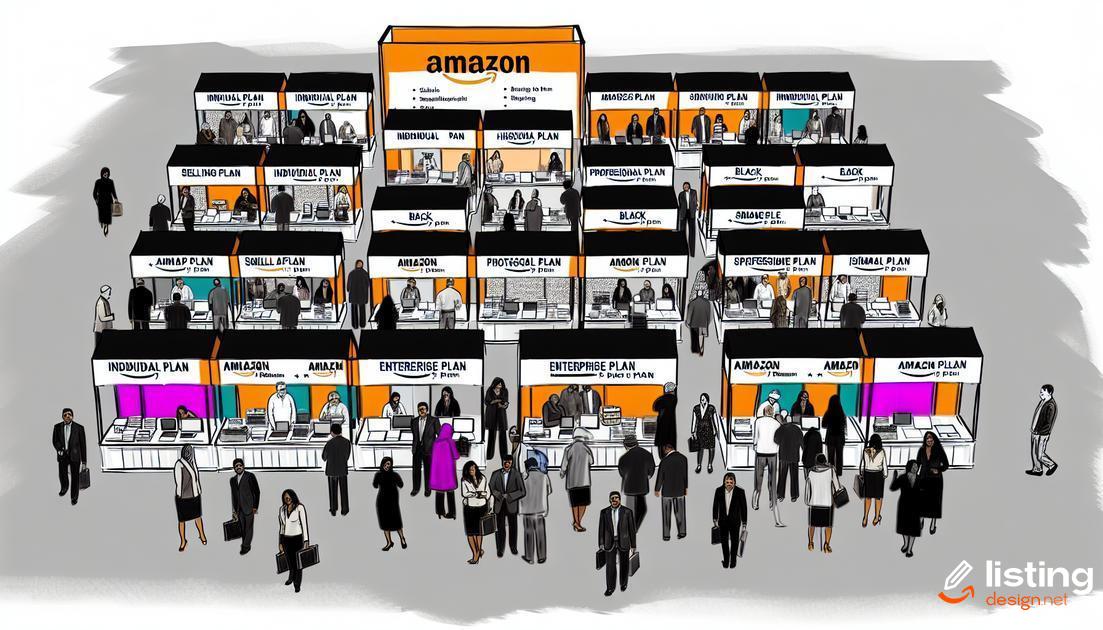Selling on Amazon can be incredibly lucrative, but understanding the various selling fees involved is crucial. This guide will help you navigate Amazon selling fees, allowing you to minimize costs and maximize profits. Let’s dive deep into the essential aspects of selling fees, from referral fees to subscription plans, and learn how to manage them effectively.
Table of Contents
Understanding Amazon Selling Fees
When selling on Amazon, it’s crucial to comprehend the various fees charged to avoid unexpected costs. Amazon offers two main selling plans: the Individual Plan and the Professional Plan. The Individual Plan has a per-item fee of $0.99, making it suitable for sellers with fewer than 40 sales per month. On the other hand, the Professional Plan requires a $39.99 monthly subscription fee but allows for unlimited sales, catering to high-volume sellers.
Referral fees are charged on each sold item, varying by category. Standard rates range from 6% to 45%, with most categories charging around 15%. For instance, books have a referral fee of 15%, whereas Amazon device accessories carry a fee of 45%. These fees are calculated from the total sales price, including shipping and gift wrap charges.
Amazon offers the Fulfillment by Amazon (FBA) service, where sellers can store their products in Amazon’s fulfillment centers. With FBA, Amazon handles packing, shipping, customer service, and returns. However, this convenience comes at a cost, as sellers must pay fulfillment and storage fees. Fulfillment fees are based on the product size and weight, with standard size items starting at $2.50 per unit. Storage fees are monthly and per cubic foot. From January to September, standard storage fees are $0.75 per cubic foot, while in October through December, they increase to $2.40 due to higher demand.
To ensure transparency and proper cost management, sellers should be aware of Amazon’s additional fees, such as High-Volume Listing Fees for having over 100,000 listings, and Refund Administration Fees, which apply when a refund is processed.
Types of Selling Plans on Amazon

When selling on Amazon, it’s crucial to choose the right selling plan that suits your business needs. Amazon offers three primary selling plans, each designed to cater to different types of sellers.
Individual Selling Plan
The Individual Selling Plan is best for sellers who plan to sell fewer than 40 items per month. With this plan, you pay a fee for each item sold rather than a monthly subscription fee. It’s a flexible option for beginners or small-scale sellers. The per-item fee for the Individual plan is typically $0.99 per item, plus other applicable fees such as referral and variable closing fees.
Professional Selling Plan
This plan is ideal for sellers who expect to sell more than 40 items per month. The Professional Selling Plan requires a monthly subscription fee of $39.99, which allows you to list an unlimited number of products. In addition to the monthly fee, sellers are also subject to referral fees and variable closing fees. This plan offers advanced selling tools including inventory management, order management reports, and customizable shipping rates.
Amazon Business (B2B) Plan
The Amazon Business Plan caters specifically to businesses looking to sell in bulk to other businesses. Sellers can access features such as bulk pricing, tax exemptions and integration with procurement systems. This plan is under the Professional Selling Plan, so the standard $39.99 monthly subscription applies alongside the added benefits for B2B transactions. Sellers will also incur standard referral fees and variable closing fees.
Choosing the right selling plan can significantly impact your profitability and efficiency when selling on Amazon. Consider the volume of your sales, the type of products, and your business goals when selecting a plan.
Referral Fees on Amazon
In the realm of Amazon selling fees, referral fees stand out as pivotal costs that sellers must account for. These charges are a percentage of the total sales price, inclusive of the item price, shipping cost, and any gift-wrapping fees. The exact percentage varies across different categories, with rates generally ranging from 6% to 45%.
For instance, for electronics, the referral fee might be around 8%, whereas for jewelry, it could be as high as 20%. Hence, it is crucial for sellers to meticulously review the category-specific referral fee chart provided by Amazon.
Additionally, despite Amazon having a minimum referral fee for certain categories, understanding the fee structure can help in better pricing strategies. For example, in the apparel category, if a product’s price is low, the referral fee might be a flat rate instead of a percentage.
Sellers should also note that these fees are applied per item sold. It is significant to incorporate these costs into your selling strategy to maintain profitability. As these fees directly impact the margins, comprehending their structure ensures that sellers remain competitive yet profitable on the platform.
Amazon Subscription Fees

When selling on Amazon, you must consider the Amazon subscription fees. These are recurring fees charged to sellers who choose to subscribe to Amazon’s selling plans. Depending on your selling strategy, there are different plans catered to your needs, primarily the Individual Selling Plan and the Professional Selling Plan.
The Individual Selling Plan charges you a fee per item sold, making it suitable for sellers who sell less than 40 items per month. Meanwhile, the Professional Selling Plan carries a monthly subscription fee but no per-item fees, ideal for sellers expecting higher monthly sales volumes.
Choosing the right plan can significantly impact your profitability. The Professional Selling Plan not only offers cost advantages for high-volume sellers but also provides access to additional seller tools and reports that can help optimize your sales strategy.
Consider your sales projections and choose the subscription plan that aligns with your business model to effectively manage and minimize costs.
Fulfillment by Amazon (FBA) Fees
Long-term storage fees
, another crucial aspect to watch, are applied to items stored for more than 365 days. These fees can significantly impact your profitability, so it’s advisable to track your inventory turnover carefully to avoid long-term storage penalties.
Storage Fees and Long-Term Storage Fees

Storage fees are the costs sellers incur for storing their products in Amazon’s fulfillment centers. These fees are typically charged monthly and are based on the volume of the products stored. Monthly storage fees are usually calculated per cubic foot and vary depending on the time of year, with higher rates often applied during peak seasons such as October to December.
In addition to standard storage fees, sellers must also account for long-term storage fees (LTSF). These are additional charges imposed on inventory that has been stored in Amazon’s fulfillment centers for more than 365 days. To minimize these fees, it is crucial for sellers to manage their inventory efficiently, ensuring that slow-moving items are either sold through promotions or removed from storage before they incur long-term storage fees.
Both storage fees and long-term storage fees can significantly impact a seller’s profit margins if not managed effectively. Sellers should regularly review their inventory levels and sales data to optimize storage costs. Additionally, employing strategies such as inventory forecasting and utilizing Amazon’s Inventory Performance Index (IPI) can help in maintaining optimal inventory levels and minimizing unnecessary fees.
High-Volume Listing Fees
High-volume listing fees are applicable when sellers exceed the free listing threshold set by Amazon. Sellers listing a large number of products need to pay attention to these fees to avoid unexpected costs.
Threshold for High-Volume Listings
Amazon typically allows a certain number of free listings each month. Once you surpass this limit, additional fees are charged per listing. Familiarize yourself with the specific thresholds for your selling account, as these can vary depending on your selling plan and category of products.
Calculating High-Volume Listing Fees
To calculate high-volume listing fees, track the number of active listings per month. Multiply the number of listings exceeding the free threshold by the fee per listing. For example, if the threshold is 1,000 free listings and you have 1,200 active listings, the fee applies to the 200 additional listings.
Strategies to Manage Fees
To manage high-volume listing fees, optimize your product catalog. Regularly audit your listings and remove inactive or duplicate listings. Prioritize high-demand products to maximize sales opportunities within the given free listing threshold.
Additionally, consider leveraging Amazon’s bulk listing and inventory management tools. These tools can streamline the listing process and help you stay within the free listing threshold, reducing overall fees.
Refund Administration Fees

When a customer requests a refund, Amazon charges a refund administration fee. This fee compensates for the cost of processing the refund and is usually a small portion of the original sale.
How is the Refund Administration Fee Calculated?
The fee is calculated as either $5.00 or 20% of the refunded charge, whichever is less. For example, if you provide a refund of $30, 20% of this amount is $6. Since $6 is more than $5, you will only be charged $5.
Impact on Profit Margins
Refund administration fees can eat into your profit margins, especially if you experience a high volume of returns. It’s crucial to account for these fees when pricing your products to ensure you remain profitable.
Ways to Minimize Refunds
Accurate Listings: Ensure that your product listings are accurate and detailed to set clear expectations for buyers.
Quality Control: Maintain high-quality standards for your products to reduce the likelihood of returns.
Customer Service: Provide excellent customer service to handle concerns before they result in refund requests.
Additional Selling Fees
Besides the standard fees, sellers may encounter additional selling fees which can impact their margins if not managed properly.
Closing Fees
For each media item sold (books, DVDs, music, etc.), Amazon charges a closing fee of $1.80. This is separate from the referral fee and applies to individual and professional sellers alike.
High-Volume Listing Fees
If you make more than 100,000 active listings on Amazon, you’ll need to pay high-volume listing fees. This is usually applied monthly and can accumulate if you have a large inventory.
Refund Administration Fees
When processing a return, Amazon retains a portion of the referral fee (known as the refund administration fee). This helps cover the costs involved in managing returns and customer support.
Currency Conversion Fees
For sellers outside the US, currency conversion fees are something to consider. Amazon charges competitive conversion rates, but they can still add up if you’re processing large volumes of sales.
Long-Term Storage Fees
Although primarily discussed under FBA fees, it’s crucial to remember that long-term storage fees can apply if inventory remains in an Amazon warehouse for over a year.
Staying aware of these additional fees will help you navigate the complexities of selling on Amazon and plan your pricing strategies effectively.
How to Minimize Amazon Selling Fees

One effective way to reduce your Amazon selling fees is by choosing the right selling plan that aligns with your sales volume. The Individual plan is suitable for sellers who intend to sell fewer than 40 items per month, while the Professional plan is better for those exceeding this threshold.
Another strategy to minimize fees is to optimize your product categories to ensure you are paying the lowest possible referral fees. Referral fees vary across different categories, so selecting the optimal category for your products can result in significant savings.
Utilizing Fulfillment by Amazon (FBA) wisely can also help in cutting costs. By sending larger shipments to Amazon’s fulfillment centers, you can reduce the per-unit shipping cost and leverage Amazon’s shipping discounts.
Avoid incurring long-term storage fees by managing your inventory levels effectively. Regularly review your stock levels and remove slow-moving items to avoid the accumulation of high storage costs.
Stay informed about all the possible additional selling fees that may apply to your account, such as high-volume listing fees and refund administration fees. By understanding these fees and planning accordingly, you can better manage your expenses.
Lastly, always compare your total Amazon fees with potential savings and benefits from other marketplaces. Sometimes, selling on an alternative platform might be more cost-effective for certain products.
Comparing Amazon Selling Fees with Other Marketplaces
When comparing Amazon’s selling fees with other marketplaces, it is essential to understand the specific costs associated with each platform to make an informed decision.
eBay: eBay charges an insertion fee for each listing and a final value fee when the item sells. The final value fee is a percentage of the total amount of the sale, including shipping.
Etsy: On Etsy, sellers pay a listing fee for each item and a transaction fee based on the item’s price. Additionally, there are payment processing fees for transactions made through Etsy Payments.
Shopify: With Shopify, sellers pay a monthly subscription fee for the platform’s services. Additionally, Shopify charges transaction fees unless using Shopify Payments as the payment gateway.
Walmart: Sellers on Walmart Marketplace pay a referral fee for each sale, similar to Amazon. The referral fee varies by category, and there is no monthly subscription fee.
It is important to compare the total cost of selling on each platform, including subscription fees, referral fees, and any additional charges, to determine the most cost-effective solution for your business. By analyzing these fees, sellers can optimize their selling strategy and choose the marketplace that best aligns with their profit goals.
Conclusion: Is Selling on Amazon Worth It?

Selling on Amazon can be highly profitable, but the fees involved can eat into your margins if not managed correctly. Analyzing the costs and aligning them with your business strategy is crucial.
Amazon’s Fee Structure: Amazon has a comprehensive fee structure, including referral fees, subscription fees, and additional costs like FBA and storage fees. It’s important to understand each component to manage your expenses effectively.
Referral Fees:
These are a percentage of your product’s price, which can range depending on the category. Carefully selecting your categories and pricing can help minimize these costs.
Subscription Fees:
There are Individual and Professional selling plans. For high-volume sellers, the Professional plan is usually more cost-effective.
Fulfillment by Amazon (FBA) Fees:
While FBA can save time and logistics hassle, it comes with its own set of fees, including storage and fulfillment costs. Evaluate whether FBA’s convenience outweighs its cost for your business model.
Minimizing costs and maximizing profits on Amazon involves thorough planning and continuous management. By leveraging the right strategies and tools, sellers can effectively navigate the fee structures and enhance their profitability.


